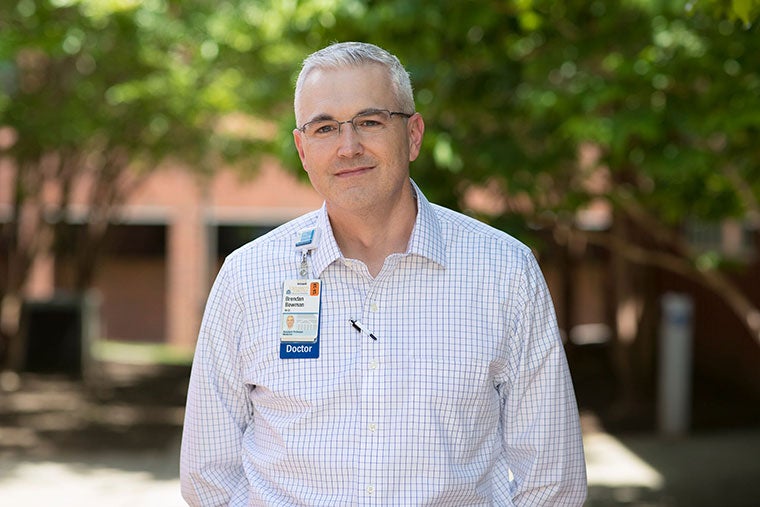
Data scientists Benjamin Lobo, left, and Don Brown, center, discuss study findings with Dr. Brendan Bowman, director of UVA’s 11-clinic dialysis system. (Photos by Dan Addison, University Communications)
Kidney disease affects approximately 30 million Americans. About 650,000 of these individuals – including nearly 15,000 Virginians – suffer from end-stage renal disease, requiring prolonged dialysis, the mechanical cleansing of blood. The University of Virginia cares for more than 900 of these patients at its 11 dialysis clinics around the state.
“Dialysis patients suffer high hospitalization rates, high health care costs and higher mortality than many patients with chronic diseases,” said Dr. Brendan Bowman, a nephrologist and director of UVA’s dialysis system. “We would like to improve treatment outcomes while also cutting costs for this treatment.”
To do this, Bowman and other physicians are working with UVA systems engineers and data scientists on developing predictive techniques to improve medication dosing protocols. The research is funded by UVA’s Engineering in Medicine program, which brings together medical clinicians and engineers to create better health outcomes, as well as by Virginia’s Center for Innovative Technology.

Dr. Brendan Bowman sought to improve treatments for dialysis patients while cutting costs, and found a possible solution using data science.
The study’s early findings, a nine-month pilot project, suggest that the UVA dialysis system could improve the treatment of low red blood cell counts, known as anemia, while simultaneously reducing unnecessary usage of an expensive anemia treatment medication by 25%. This could result in a better quality of life for dialysis patients and potential savings to the UVA Health System of $750,000 to $1 million per year.
Kidney disease can occur for many reasons, but commonly it is the result of strain put on the organ by other chronic diseases, such as diabetes and high blood pressure. Over time, the kidney’s efficiency at removing impurities from the blood can diminish to the point where a patient requires dialysis three times per week. This usually involves visiting a clinic, being connected to a dialysis machine, and having the blood – all of it – cycled through a filter, cleansed of toxins and impurities, and returned to the body. Patients with end stage renal disease often will have to do this for life, or, if fortunate, until undergoing a kidney transplant.
Patients with end-stage renal disease universally suffer from anemia, which can cause shortness of breath, fatigue, malaise and light-headedness, among other afflictions. Clinicians treat anemia with expensive injectable medications, erythropoietin chief among them, to stimulate red blood cell production – a task typically handled by a healthy kidney.
How much medication to use, however, is not one-size-fits-all; it is as much art as science. Each patient is different, some requiring more medication than others, and clinicians must fine-tune their dosing during the course of months, always adjusting to find that “sweet spot” in the cycle where the patient receives just enough medication to return red blood cell counts to near normal, but not so much that the patient experiences harmful side effects, or to be wasteful of expensive medicines.
Unfortunately, the effect of each dosage change takes approximately two to three months to take effect, while dosing decisions are made monthly. Thus there is a tendency for hemoglobin cycling to occur, where the patient’s red blood cell count values alternate between too high, causing the patient to experience drug side effects, or too low, causing the patient to feel symptoms of anemia. An adjustment ensues and the cycle repeats for another two to three months.
“We want to smooth out the ride for our patients, which will make them feel better. Severe anemia has also been associated with missed dialysis treatment sessions and higher mortality, so there may be other positive effects downstream,” Bowman said.
This is where systems and information engineering professor Don Brown comes in. Brown is the founding director of UVA’s Data Sciences Institute, co-director of the Translational Health Institute of Virginia and a master at teasing out meaning from reams of data – what is often called “big data.”
Don Brown, the founding director of the Data Sciences Institute, applied “classical engineering” to solving the hemoglobin cycling dilemma.

Don Brown, the founding director of the Data Sciences Institute, applied “classical engineering” to solving the hemoglobin cycling dilemma.
According to Brown, this is “basically a control problem, which is classical engineering. We can use historical data to inform how we make decisions now to affect future conditions. The goal is to develop a system that can help clinicians more accurately control and predict their patient’s red blood cell counts based on what we glean from large data samples from the past.”
Bowman, it turns out, has reams of data – dosing records for some 3,000 patients over a decade of care. Sifting through those treatment records to find ideal dosing levels under a wide range of conditions is a formidable task, requiring sophisticated data analytics techniques.
Benjamin Lobo, a research scientist in the UVA School of Engineering and Applied Science, working with Brown, Bowman and others, has built a model that can predict treatment outcomes based on data from past experience to more quickly tailor treatment toward that sweet spot that will improve patients’ daily lives, reduce mortality and cut back on the overuse of expensive medication.
Research scientist Benjamin Lobo built a model that can predict treatment outcomes based on data from past experiences.
“We are seeking precision dosing; to be able to reliably predict a treatment outcome prior to actual treatment,” Bowman said. “By partnering with big data engineers, we are developing a decision support tool that should really help our clinicians provide the best and most effective treatment possible while getting the most from our health care dollar.
“We first set out to stabilize the anemia cycling problem for patients in our pilot and we’ve now shown we can improve that by over 70%. The cost savings; however, were a surprise. Now, we hope to replicate this in a much larger patient group. It has been great to get such positive results from the get-go.”
The new analytics method could offer commercialization opportunities for UVA under licensing to other medical institutions and might be applicable to treatment protocols for possibly a range of diseases, the researchers noted.
In addition to Bowman, Brown and Lobo, the research team includes nephrologist Dr. Emaad Abdel-Rahman; clinical pharmacist Lori Dunn; and data scientists Jonathan Michel and Kasi Vegesana with the UVA Health System’s Quality and Performance Improvement Team.
By Fariss Samarrai, Reposted from UVA Today
Filed Under: Media Highlights, Research

Comments